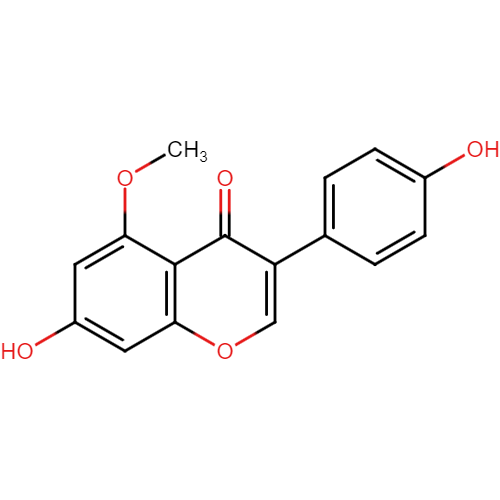5’-methylgenistein
| Compound Structure: |

|
|---|---|
| Synonyms: | 5-O-Methylgenistein;Isoprunetin;4569-98-6;Q2UG76ML8U;7-Hydroxy-3-(4-hydroxyphenyl)-5-methoxy-4H-1-benzopyran-4-one;UNII-Q2UG76ML8U;4H-1-Benzopyran-4-one, 7-hydroxy-3-(4-hydroxyphenyl)-5-methoxy- |
| Compound ID: | NMPC-443 |
| PubChem ID: | |
| Molecular Formula: | C16H12O5 |
| Canonical SMILES: | COC1=CC(=CC2=C1C(=O)C(=CO2)C3=CC=C(C=C3)O)O |
| InChIKey: | YSINCDVRUMTOPK-UHFFFAOYSA-N |
| About the compound: | 5-O-Methylgenistein, also recognized by its alternate name Isoprunetin, belongs to the O-methylated isoflavone class, which is a type of flavonoids. Flavonoids are polyphenolic substances known for their health-promoting properties. This specific isoflavone is discovered in the tropical legume Ormosia excelsa. Its structure is marked by a molecular weight of 284.26 g/mol, with the formula C16H12O5, and features a furan ring, an aldehyde group, and a hydroxymethyl group. These structural elements are crucial for its chemical reactivity and potential benefits in biology[1]. The exploration of 5-O-Methylgenistein and related molecules is driven by their antioxidant capabilities, in addition to other health-related properties. The category of flavonoids, including 5-O-Methylgenistein, has garnered interest for its distinct biological effects, which are considered valuable for pharmaceutical uses. For instance, research involving the receptacles of the sunflower (Helianthus annuus L.) focused on the identification and extraction of total flavonoids such as 5-O-Methylgenistein, to evaluate their capacity to neutralize free radicals. This study highlights the role of natural flavonoids as antioxidants, suggesting their potential utility in pharmaceuticals [2,3]. References 1. "5-O-Methylgenistein." Wikiwand. https://www.wikiwand.com/en/5-O-Methylgenistein. 2. Lu Han, Xinsheng Liu, Huining Dai, Changmin Liu, Min Yan, Wannan Li, Weiwei Han, Xinlu Li, Silu Huang, Bo Gao. "Extraction, Radical Scavenging Activities, and Chemical Composition Identification of Flavonoids from Sunflower (Helianthus annuus L.) Receptacles." Molecules, 2021, 26(2), 403. MDPI. https://doi.org/10.3390/molecules26020403. 3. Jiang, Z., Zeng, Y., Hu, D., Guo, R., Yan, K., & Luque, R. (2023). Chemical transformations of 5-hydroxymethylfurfural into highly added value products: present and future. Green Chemistry, 25(3), 871-892. GHS Hazard Statements • H301 (100%): Toxic if swallowed [Danger Acute toxicity, oral] • H400 (100%): Very toxic to aquatic life [Warning Hazardous to the aquatic environment, acute hazard] • H410 (100%): Very toxic to aquatic life with long lasting effects [Warning Hazardous to the aquatic environment, long-term hazard] |
| Properties: | |
| Source Species: |
Momordica balsamina Leptadenia hastata |